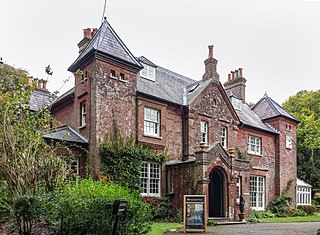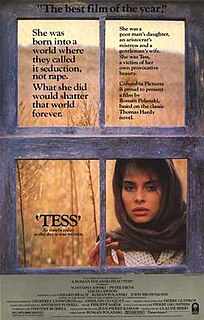
Thomas Hardy was an English novelist and poet. A Victorian realist in the tradition of George Eliot, he was influenced both in his novels and in his poetry by Romanticism, including the poetry of William Wordsworth. He was highly critical of much in Victorian society, especially on the declining status of rural people in Britain, such as those from his native South West England.

Tess of the d'Urbervilles: A Pure Woman Faithfully Presented is a novel by Thomas Hardy. It initially appeared in a censored and serialised version, published by the British illustrated newspaper The Graphic in 1891, then in book form in three volumes in 1891, and as a single volume in 1892. Though now considered a major 19th-century English novel, even Hardy's fictional masterpiece, Tess of the d'Urbervilles received mixed reviews when it first appeared, in part because it challenged the sexual morals of late Victorian England. Tess was portrayed as a fighter not only for her rights, but also for the rights of others.

Sharp County is a county located in the U.S. state of Arkansas. As of the 2010 census, the population was 17,264. The county seat is Ash Flat. The county was formed on July 18, 1868, and named for Ephraim Sharp, a state legislator from the area.

Ash Flat is a city in Fulton and Sharp counties in the U.S. state of Arkansas. The population was 1,082 at the 2010 census. The city is the county seat of Sharp County.

Hardy is a city in Sharp and Fulton counties in the U.S. state of Arkansas. The population was 772 at the 2010 census.
The Big Read was a survey on books carried out by the BBC in the United Kingdom in 2003, where over three-quarters of a million votes were received from the British public to find the nation's best-loved novel of all time. The year-long survey was the biggest single test of public reading taste to date, and culminated with several programmes hosted by celebrities, advocating their favourite books.

Max Gate is the former home of Thomas Hardy and is located on the outskirts of Dorchester, Dorset, England. It was designed and built by Thomas Hardy for his own use in 1885 and he lived there until his death in 1928. In 1940 it was bequeathed to the National Trust by Hardy's sister and is now open to the public. It was designated as a Grade I listed building on 8 May 1970.
The Earl G. Maxwell Arboretum is a 5-acre (2.0 ha) arboretum and botanical garden located on the East Campus of the University of Nebraska–Lincoln in Lincoln, Nebraska.

St Juliot is a civil parish in north-east Cornwall, England, United Kingdom. The parish is entirely rural and the settlements within it are the hamlets of Beeny and Tresparrett. - plus a part of the adjacent village of Marshgate. The parish population at the 2011 census was 328.

Thomas Hardy's Wessex is the fictional literary landscape created by the English author Thomas Hardy as the setting for his major novels, located in the south and southwest of England. Hardy named the area "Wessex" after the medieval Anglo-Saxon kingdom that existed in this part of that country prior to the unification of England by Æthelstan. Although the places that appear in his novels actually exist, in many cases he gave the place a fictional name. For example, Hardy's home town of Dorchester is called Casterbridge in his books, notably in The Mayor of Casterbridge. In an 1895 preface to the 1874 novel Far From the Madding Crowd he described Wessex as "a merely realistic dream country".
Research Video is a music footage library operating from North Hollywood, Los Angeles. The company was formed in 1984 by partners John Delgatto and Paul Surratt. Paul Surratt was also an ex-Shilos member, a folk group headed by Gram Parsons. John Delgatto left the company in March 1988 to return full time to his record label, Sierra Records. Paul Surratt owns the rights to an extensive collection of television and film footage dating back to the 1950s. Surratt's company also performs video restoration serving clients that vary from Dinah Shore and Perry Como to ABC and NBC.

Blackdown is a small village in western Dorset, England; situated 7 miles (11 km) west of Beaminster. With the creation of the new Dorset Council, Blackdown is now part of the new Marshwood Vale Ward. The local travel links are located 5 miles (8.0 km) from the village to Crewkerne railway station and 25 miles (40 km) to Exeter International Airport. The main road through the village is the B3165, connecting Blackdown and Lyme Regis. The village has a population of 128 according to the 2001 Census. The village and surrounding area makes up the Blackdown ward of the Broadwindsor Group Parish Council which besides the few houses in Blackdown includes Kittwhistle, Templeman's Ash (part), Laymore (part), Coles Cross, Causeway Lane, Venn, Southcoombe, Stoney Knapp, Schoolhouse Lane, Speckets Lane, Racedown, Cockpit, Horn Ash, Berechapel, Childhay, two houses in Synderford, two houses in Birdsmoregate including the old Rose & Crown Public House now a private residence it is split between many postcodes partly due to the County boundary being realigned in the 1960s. Residents have postcodes with the main town as either Beaminster, Bridport, Crewkerne or Chard. Divisions also arise within telephone exchange areas, the BT phone box was removed from the centre of Blackdown in March 2017. Water services are provided by either South West Water or Wessex Water.

Tess of the D'Urbervilles is a 4-hour BBC television adaptation of Thomas Hardy's 1891 book of the same name. The script is by David Nicholls. It tells the story of Tess Durbeyfield, a low-born country girl whose family find they have noble connections.

Transiting Exoplanet Survey Satellite is a space telescope for NASA's Explorer program, designed to search for exoplanets using the transit method in an area 400 times larger than that covered by the Kepler mission. It was launched on 18 April 2018, atop a Falcon 9 launch vehicle and was placed into a highly elliptical 13.70-day orbit around the Earth. The first light image from TESS was taken on 7 August 2018, and released publicly on 17 September 2018.

Woolbridge Manor is a 17th-century manor house in East Stoke, just outside the village of Wool, in Dorset, England. English Heritage have designated it a Grade II* listed building. It is on the north side of the old Wool bridge, a historic crossing point over the River Frome, now closed to traffic except pedestrians and cyclists due to a bypass and junction.

Tess of the d'Urbervilles is a 1924 American silent drama film starring Blanche Sweet and Conrad Nagel. It was directed by Sweet's husband, Marshall Neilan. The film is the second motion picture adaptation of the 1891 novel by Thomas Hardy, which had been turned into a very successful 1897 play starring Mrs. Fiske. In 1913, Adolph Zukor enticed Mrs. Fiske to reprise her role in a film version which is now considered lost. The 1924 version is also considered lost.

Tess is a 1979 drama film directed by Roman Polanski and starring Nastassja Kinski, Peter Firth, and Leigh Lawson. It is an adaptation of Thomas Hardy's 1891 novel Tess of the d'Urbervilles. The screenplay was written by Gérard Brach, John Brownjohn, and Roman Polanski. The film received positive critical reviews upon release and was nominated for six Academy Awards, including Best Picture, winning three for Best Cinematography, Best Art Direction and Best Costume Design.
Tess is a feminine given name, typically a diminutive form of Theresa or Esther.

Barons Court Theatre is a small theatre of 52 cinema-style seats located in the basement of The Curtains Up public house in Comeragh Road in West London. Founded in 1991, the Barons Court Theatre features a programme of short-run plays and afternoon magic shows that are frequently changed.

Ulmus × hollandica 'Wentworthii Pendula', commonly known as the Wentworth Elm or Wentworth Weeping Elm, is a cultivar with a distinctive weeping habit that appears to have been introduced to cultivation towards the end of the 19th century. The tree is not mentioned in either Elwes and Henry's or Bean's classic works on British trees. The earliest known references are Dutch and German, the first by de Vos in Handboek tot de praktische kennis der voornaamste boomen (1890). At about the same time, the tree was offered for sale by the Späth nursery of Berlin as Ulmus Wentworthi pendulaHort.. The 'Hort.' in Späth's 1890 catalogue, without his customary label "new", confirms that the tree was by then in nurseries as a horticultural elm. De Vos, writing in 1889, states that the Supplement to Volume 1 includes entries announced since the main volume in 1887, putting the date of introduction between 1887 and 1889.
















